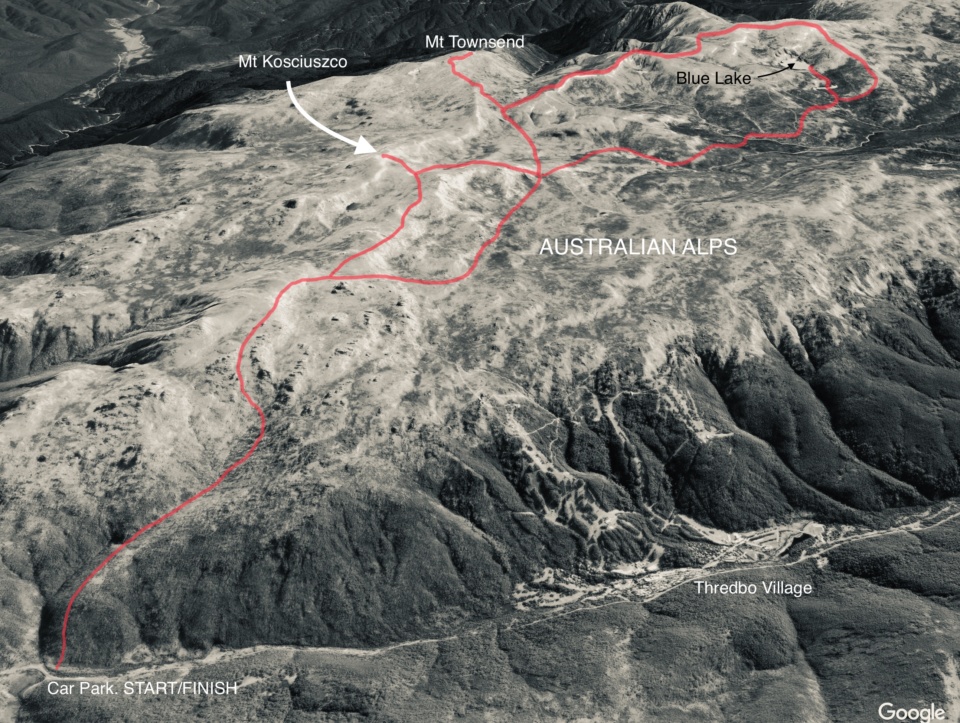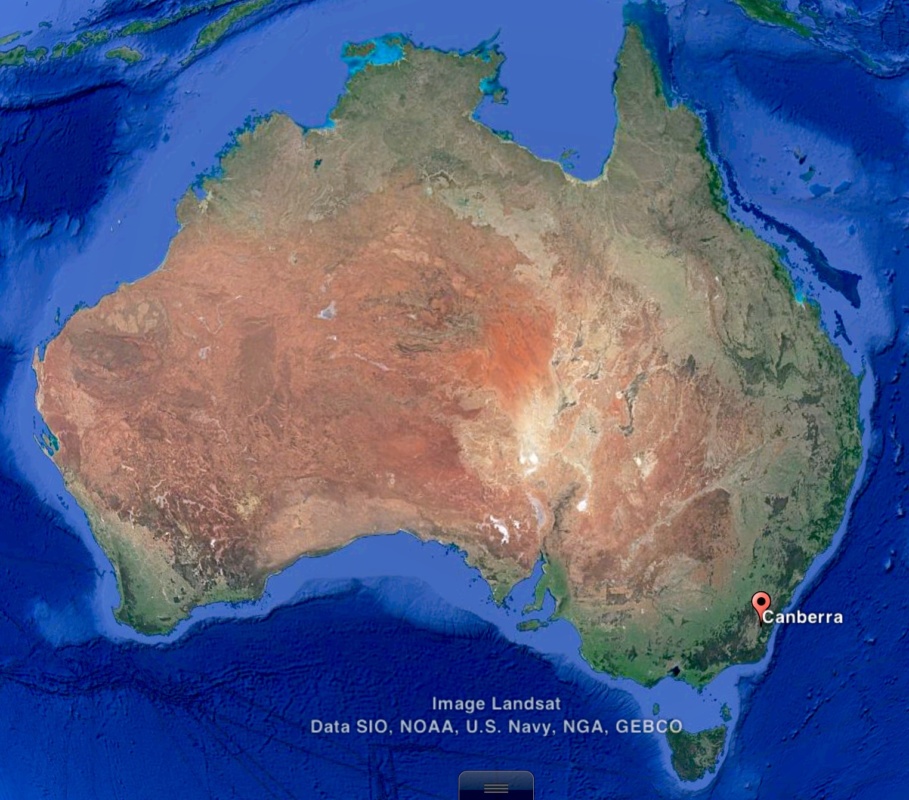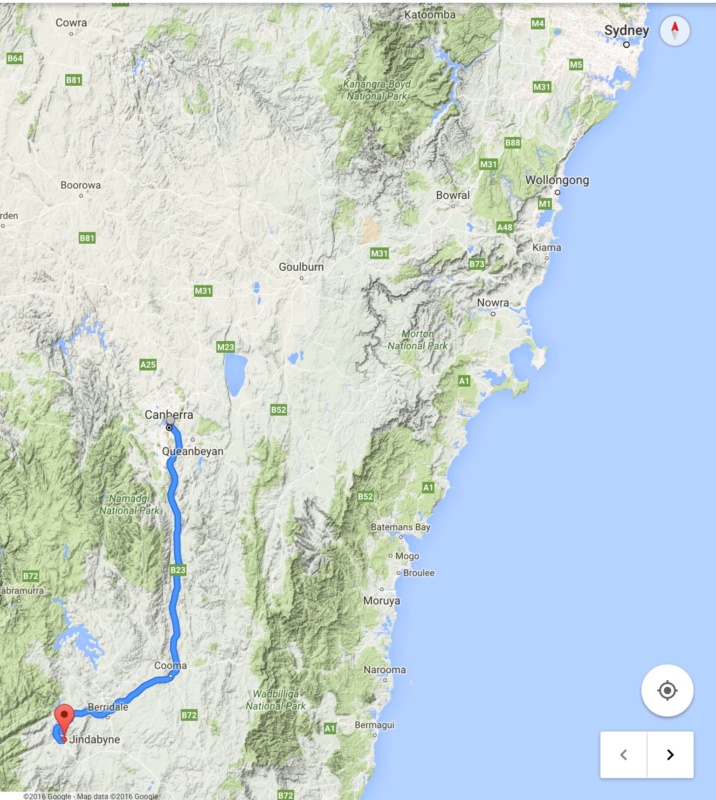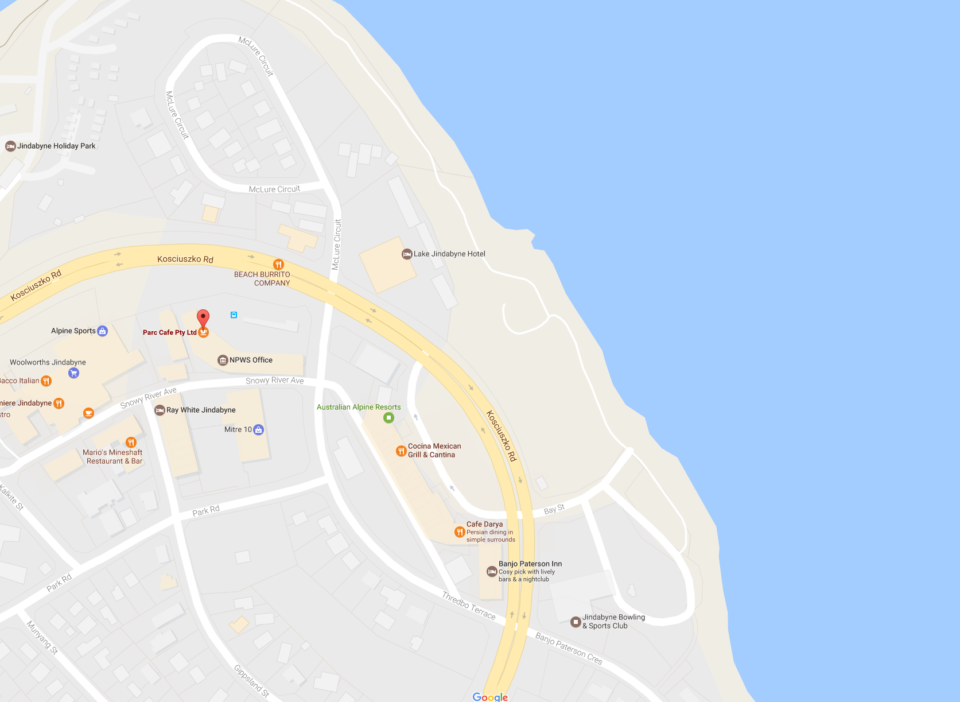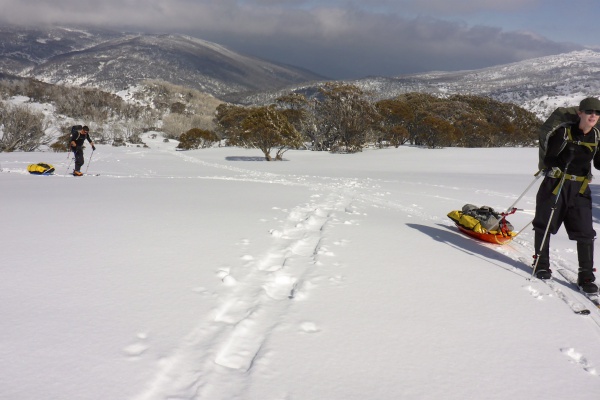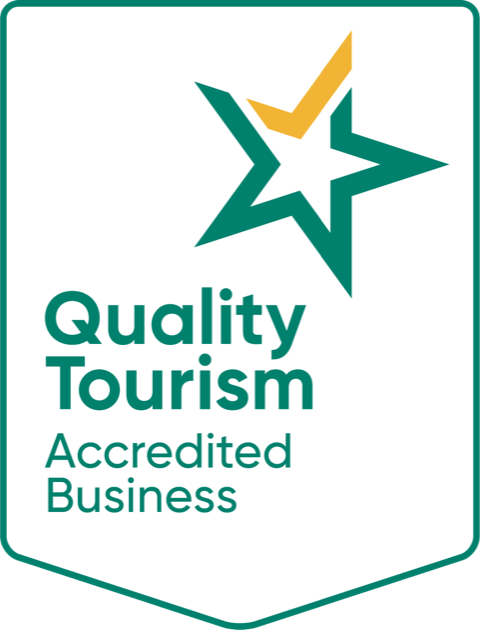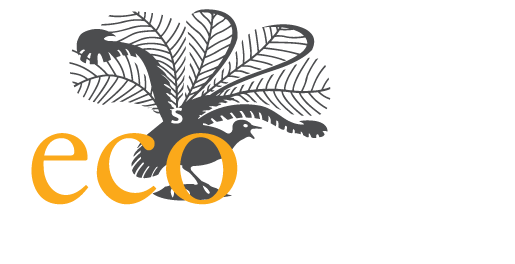Trek to the summit of Mt Koscuiszco, and beyond.
This ski/snowshoe tour is a superb trip for anyone wanting to experience the joys of Australian ski-touring. It's also a great polar training program that covers the basics of a sled-hauling expedition.
- Gateway Jindabyne, Australia
- Distance 60km
- Days on Ice 7
- Daily Distance 5-10km of mountainous terrain
- Temp. Range 0 to -15C
- Sled Weight 25kg
- Challenge 4 What's this?
- Conditions Dampness, dark nights. Blue skies to blizzards.
- Challenges Long climbs and descents, undulating traverses, dampness
Trip Itinerary
Meet 9.30am in Jindabyne at the Parc Café situated in the National Parks Visitor Centre, next to the bus terminal. Preparation and gear check. Drive to Cascade car park (Dead Horse Gap) in the afternoon and begin trip.
Ski and snowshoe trek in the Snowy Mountains, including an ascent of Mt. Koscuiszco.
Return to Cascade Car Park. Drive to Jindabyne.
Inclusions
- Transportation from Jindabyne to start and from finish to Jindabyne
- Entry to National Park
- Expedition food and stove fuel
- Icetrek guide
- Use of specialist equipment including:
- Skis, bindings, skins, ski poles, snowshoes
- Sled, hauling bars and waterproof sled bag
- Tents, snow tools and stoves.
This equipment is returned to Icetrek after the training (see equipment list).
- 20% discount on selected Icetrek Equipment (hand and head wear)
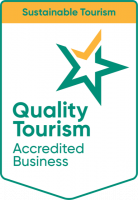
Exclusions
- Accommodation and meals in Jindabyne
- Additional costs (accommodation, meals etc.) due to changes beyond our control ie. weather delays
- Insurance
We meet in Jindabyne on the east side of the Australian Alps. Here we make final preparations to ensure you are kitted up for a week in the Australian Alps. It's winter here, the mountains are full of snow, there's a chill in the air, so expect adventure.
Sleds prepared, a 45-minute drive takes us to Dead Horse Gap on the spine of the Main Range where our adventure begins. On skis or snowshoes (your choice), a long climb up a spur lined with beautiful snowgums takes us above the tree-line where we see one of Australia's great treasures - the Snowy Mountains. A narrow ridge adorned with granite tors widens to rolling hills flanked either side by steep slopes and it's across this magical plateau that we venture.
Hauling small sleds with our food and equipment we negotiate the terrain ahead - snow slopes, icy ridges, sastrugi, cornices, descents, and a climb of Australia's highest peak, Mt Koscuiszco (2228m).
We visit the best that the Australian Alps has to offer - the Rams Heads, Mt Kosciuszco summit, iconic Seaman’s Hut, the spectacular Main Range and Blue Lake. We may also include Club Lake and Australia’s second highest peak, Mt Townsend.
After a week of touring across Australia's roof we return to Dead Horse Gap and return to Jindabyne. You will return with a solid insight into winter sled hauling and the confidence to undertake similar trips in a polar environment.
THINGS TO KNOW
Australian alpine winter conditions can be tough, don't under-estimate them just because they are not polar. Wind, dampness and cold can combine to produce extremely challenging conditions.
The days are quite short so expect a fair bit of tent time. We are often camped by 5pm, finished dinner by 8pm and wake around 7am the following morning. These trips are a great opportunity to catch up on sleep!
All participants will carry their own food and equipment, in a sled and in a backpack.
All participants in this advanced trip should have prior skiing/snowshoeing and preferably snowcamping experience. Please complete and submit Resumé and Medical Forms during the Registration process.
You need good quality winter outdoor equipment and footwear, check the equipment list
You must be at least 14 years old to participate
We wake at 7am and fire up the gas stove. A warm breakfast with a choice of tea, coffee or hot chocolate gets us energised for a day of sled hauling in the Snowy Mountains. After packing away our sleeping gear, taking down the tent and loading our sleds we head off on skis or show shoes for our next camp.
The sun is out but the light breeze keeps us rugged up with thermal, fleece and shell jacket. We work hard at venting - expelling the heat and moisture that builds up in our layers - as we don’t want to perspire in this environment as it cools the body quickly and makes for uncomfortable breaks. A steep slope tests our theory and we arrive at the top of a beautiful hill in fine form. A quick drink and a handful of ‘scroggin’ (nuts, dried fruit and lollies) sees us back on the trail as we descend on skis or snowshoes (your choice depending on skill level) into a wide snow-covered valley. In single file we pull into polar mode, hauling our sleds, listening to the swish of skis, focusing on the balance of skier and environment, and cruise through until lunch breaks the spell.
After putting on a cosy puffer jacket we tuck into salami and cheese, soup or hot noodles, crackers and scroggin, your choice as we sit on our foam seats and peer at the spectacular snow features that line our view - ridges, cornices, rolling hills, and Mt Kosciuszco just a couple of kilometers away.
After lunch we don our skis and set our sights on Kozzie. We leave our sleds at Rawson’s Pass where we change to snowshoes for the steep ascent. Slowly we make our way above all other peaks and stand on Mt Kosciuszco, the summit of Australia. In every direction the views are nothing short of spectacular. After photos and celebrations we snowshow back to our sleds and continue to our camp in a secluded valley. By 5pm darkness is starting to descend and we want to be settled down before last light.
Tents pitched directly on the snow, we hunker down as we do every night, securing the camp irrespective of the forecast. It’s good winter practice to prepare your camp for the worst possible conditions so that every night is a restful one. Once pitched we throw in our belongings, secure our sleds and ski gear, collect water if a nearby stream offers (or melt snow) and light the stove. A hot soup followed by dinner and chocolate fills our bellies and we might settle down to a game of cards. We provide 4-person tents for each pair so there’s plenty of room for inter-tent visits.
Tired from the day’s activity we slip into our warm sleeping bags atop a double-layer mattress and allow the day to unfold in our minds before luxuriating in 8 hours of sleep.
Airport
The nearest international airport to Jindabyne is Sydney. Canberra is a 55 minute flight from Sydney. There are small airports in Jindabyne and in Cooma.
Bus Transfers
Greyhound, SnoExpress and Murrays run winter bus services direct from Canberra/Canberra Airport to Jindabyne.
Snow Alliance run a private shuttle service from Canberra to Jindabyne
Car
From Melbourne the shortest way to Jindabyne is via Khancoban, which is on the west side of the range. However you need to check with NSW roads or National Parks to make sure the road is open. It is sometimes closed after heavy snowfalls. Parks fees are payable if entering the national park.
There are a couple of free car parks where you may leave your car during the trip.
Accommodation
We meet at 9.30am on the day of departure into the mountains so you may need to arrive in Jindabyne the night before as the buses do not arrive until the afternoon. Some places to stay:
We do not provide any accommodation in Jindabyne.
We usually return to Jindabyne by noon on the final day.
Once you have signed onto the trip you will receive an Australian Alps Trip Information Booklet which has full details of how to plan for your trip.
What will be the temperature during the trip?
The temperature will be anywhere from 0 to -15C, 32 to 5F
*
Where do we meet?
We will meet at the Parc Café in Jindabyne at 9.30am. See the Getting There tab for details.
*
Can I leave bags in Jindabyne?
You can either arrange to leave bags at your hotel, in your car if you have driven or we will find room in our vehicle. But please don't com with excessive bags and equipment.
*
How heavy will my sled be?
You sled will weigh around 25 to 30kg / 55 to 66lb.
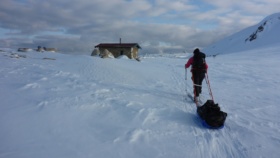
*
What type of sleds do we use?
We use Northern Sled Works Siglin Pulks made from slippery HDPE plastic and we use purpose-built conduit bar hauling traces.
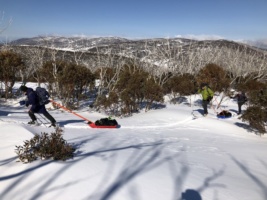
*
What if I am not a skier?
Skiing experience is preferable but not mandatory. We will spend time teaching you and you can also opt to be on snowshoes. We carry both skis and snowshoes.
*
How do we go downhill with sleds?
We usually change to snowshoes and the bar traces stop the sleds from overtaking us, they simply track in our steps. On steeper ground we unclip and reverse the bars which gives excellent stability and control.

*
How long do we ski every day on the trip?
It varies depending on the group, terrain and weather. Usually we ski between 5 to 6 hours per day not including breaks.
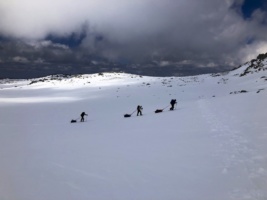
*
What is the Guide to Client ratio?
1:6
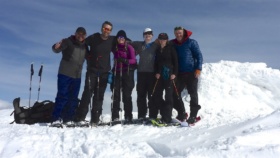
*
What type of tents do we use?
We use Hilleberg Keron 3 or 4-person tents for two people. There is plenty of room to get comfortable but small enough to warm up quickly once you are inside. You are responsible for setting up, managing and taking down your tent.
*
What will we eat on the expedition?
You can find our menu here
*
Who cooks the meals and melts the snow for water?
You do! This is a normal part of winter trip life. We train you in how to use the gas stove efficiently and carefully.
*
What if there is an emergency and how will we communicate with the outside world?
We carry a number of communications and emergency devices including an Iridium handheld phone, iPhone and PLB (Personal Locator Beacon). Our trip plans are logged with the Icetrek office and with NSW Parks.
*
Is there mobile reception?
We will have mobile reception for some of the trip but it isn't reliable so don't make any promises to be in touch with family and friends. There is reception on the summit of Mt Kosciuszco and we often post from the to Facebook from here.
*
Feel free to submit your own questions.
